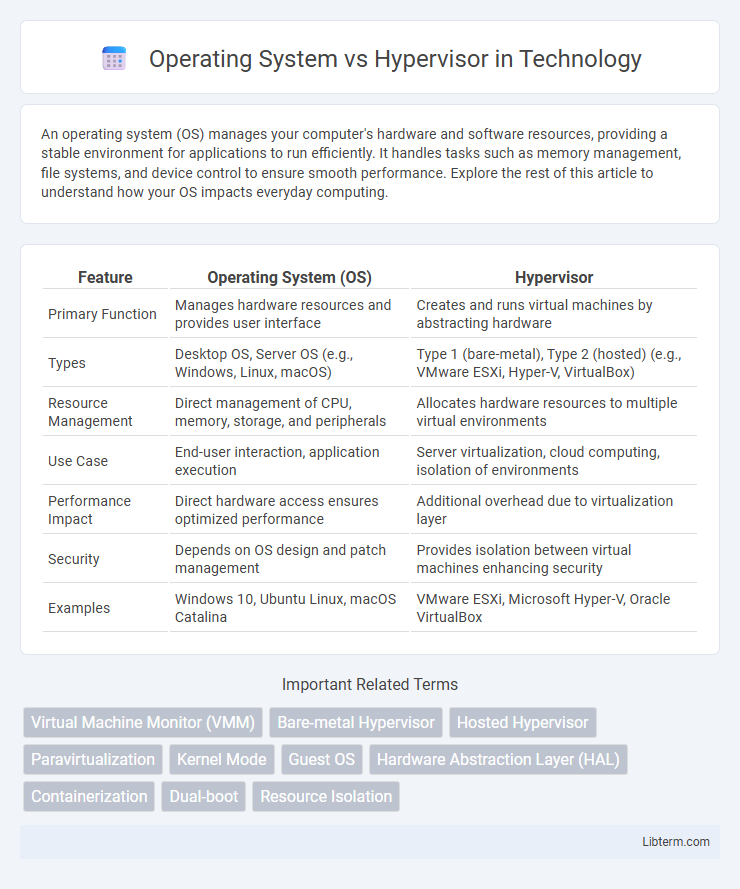An operating system (OS) manages your computer's hardware and software resources, providing a stable environment for applications to run efficiently. It handles tasks such as memory management, file systems, and device control to ensure smooth performance. Explore the rest of this article to understand how your OS impacts everyday computing.
Table of Comparison
| Feature | Operating System (OS) | Hypervisor |
|---|---|---|
| Primary Function | Manages hardware resources and provides user interface | Creates and runs virtual machines by abstracting hardware |
| Types | Desktop OS, Server OS (e.g., Windows, Linux, macOS) | Type 1 (bare-metal), Type 2 (hosted) (e.g., VMware ESXi, Hyper-V, VirtualBox) |
| Resource Management | Direct management of CPU, memory, storage, and peripherals | Allocates hardware resources to multiple virtual environments |
| Use Case | End-user interaction, application execution | Server virtualization, cloud computing, isolation of environments |
| Performance Impact | Direct hardware access ensures optimized performance | Additional overhead due to virtualization layer |
| Security | Depends on OS design and patch management | Provides isolation between virtual machines enhancing security |
| Examples | Windows 10, Ubuntu Linux, macOS Catalina | VMware ESXi, Microsoft Hyper-V, Oracle VirtualBox |
Introduction to Operating Systems and Hypervisors
Operating systems manage computer hardware and software resources, providing essential services for application execution and user interaction. Hypervisors create and manage virtual machines by abstracting hardware, enabling multiple operating systems to run concurrently on a single physical host. Understanding the core functions of operating systems and hypervisors is crucial for optimizing system performance and resource allocation in modern computing environments.
Core Functions of Operating Systems
Operating systems manage hardware resources, provide user interfaces, and enable application execution through process scheduling, memory management, and file systems. They handle device drivers for seamless hardware communication and implement security protocols for user authentication and access control. Core functions optimize resource allocation and maintain system stability to support multitasking and overall performance.
What is a Hypervisor?
A hypervisor is a specialized software layer that enables the creation and management of virtual machines by abstracting hardware resources. Unlike traditional operating systems, which directly manage hardware and run applications, hypervisors allocate physical resources to multiple isolated virtual environments, enhancing system efficiency and flexibility. Key types include Type 1 (bare-metal) hypervisors, which run directly on hardware, and Type 2 (hosted) hypervisors, which run on top of an existing operating system.
Types of Hypervisors Explained
Hypervisors are classified into two main types: Type 1 hypervisors, also known as bare-metal hypervisors, run directly on the host's hardware to manage multiple operating systems with high efficiency and security, commonly used in enterprise data centers. Type 2 hypervisors operate on top of a host operating system, providing virtualization services primarily for desktop or development environments, which offers greater flexibility but with some performance overhead. Understanding the differences between these hypervisor types aids in selecting the right virtualization solution based on workload requirements and infrastructure design.
Key Differences: OS vs Hypervisor
An operating system (OS) manages hardware resources and provides a user interface for applications to run on a physical machine, while a hypervisor creates and controls virtual machines by abstracting hardware for multiple operating systems to run concurrently. OS directly handles device drivers, file systems, and user processes, whereas hypervisors focus on virtualization, enabling isolation, resource allocation, and management of guest OS environments. Key differences include the OS running natively on hardware versus the hypervisor operating either directly on hardware (Type 1) or on top of an OS (Type 2), with hypervisors specializing in efficient multi-tenant resource sharing and isolation.
Resource Management and Allocation
Operating systems manage hardware resources such as CPU, memory, and storage by allocating them directly to running applications and processes within a single system environment. Hypervisors abstract and partition physical resources to create and manage multiple virtual machines, enabling isolated environments to share the same hardware efficiently. Resource allocation in hypervisors involves dynamic distribution and isolation of CPU cycles, memory, and I/O devices to ensure performance and security across virtual instances.
Security Implications: OS vs Hypervisor
Operating systems manage hardware resources and user applications, making them more vulnerable to attacks due to extensive codebases and higher exposure to user-level exploits. Hypervisors provide a hardened layer of abstraction between physical hardware and virtual machines, reducing attack surfaces by isolating guest operating systems and limiting direct hardware access. This isolation enhances security by containing breaches within virtual machines, preventing lateral movement and protecting the host system from compromised guests.
Use Cases and Applications
Operating systems manage hardware and software resources for general-purpose computing, supporting applications like web browsing, office productivity, and gaming on desktops or servers. Hypervisors enable virtualization by hosting multiple virtual machines, making them essential for cloud computing, data center management, and running isolated environments for software testing. Use cases for operating systems center around direct user interaction and resource management, whereas hypervisors excel in workload consolidation and infrastructure optimization.
Performance Considerations
Operating systems manage hardware resources and run applications directly, ensuring efficient CPU, memory, and I/O performance tailored to specific workloads. Hypervisors introduce an abstraction layer to enable multiple virtual machines, which can lead to overhead, affecting CPU cycles, memory allocation, and disk latency compared to native OS performance. Paravirtualization and hardware-assisted virtualization features like Intel VT-x and AMD-V help reduce hypervisor overhead, optimizing performance closer to that of a traditional operating system.
Future Trends in OS and Hypervisor Technologies
Emerging trends in operating system technologies emphasize enhanced AI integration, improved security architectures, and seamless support for edge computing environments. Hypervisor development focuses on lightweight virtualization, increased hardware acceleration compatibility, and robust multi-cloud orchestration capabilities. These advancements aim to optimize resource management and scalability in evolving distributed and hybrid IT infrastructures.
Operating System Infographic

 libterm.com
libterm.com